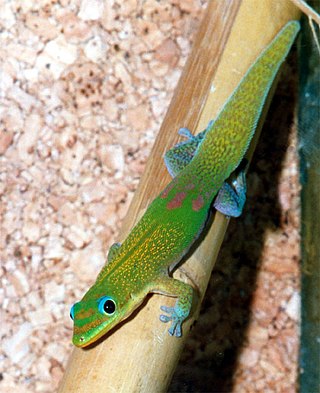
Geckos are small, mostly carnivorous lizards that have a wide distribution, found on every continent except Antarctica. Belonging to the infraorder Gekkota, geckos are found in warm climates throughout the world. They range from 1.6 to 60 centimetres.

The black-tailed skimmer is a dragonfly belonging to the family Libellulidae.
In biology, setae are any of a number of different bristle- or hair-like structures on living organisms.

Manduca quinquemaculata, the five-spotted hawkmoth, is a brown and gray hawk moth of the family Sphingidae. The caterpillar, often referred to as the tomato hornworm, can be a major pest in gardens; they get their name from a dark projection on their posterior end and their use of tomatoes as host plants. Tomato hornworms are closely related to the tobacco hornworm Manduca sexta. This confusion arises because caterpillars of both species have similar morphologies and feed on the foliage of various plants from the family Solanaceae, so either species can be found on tobacco or tomato leaves. Because of this, the plant on which the caterpillar is found does not indicate its species.

Kiwa hirsuta is a crustacean discovered in 2005 in the South Pacific Ocean. This decapod, which is approximately 15 cm (5.9 in) long, is notable for the quantity of silky blond setae covering its pereiopods. Its discoverers dubbed it the "yeti lobster" or "yeti crab".

Tetraphidaceae is a family of mosses. It includes only the two genera Tetraphis and Tetrodontium, each with two species. The defining feature of the family is the 4-toothed peristome.

Ogoveidae is a family of harvestmen with three described species in one genus, Ogovea, which is found in equatorial West Africa.

An earthworm is a terrestrial invertebrate that belongs to the phylum Annelida. They exhibit a tube-within-a-tube body plan; they are externally segmented with corresponding internal segmentation; and they usually have setae on all segments. They occur worldwide where soil, water, and temperature allow.

Micropterix aglaella is a species of moth belonging to the family Micropterigidae.It is found in southern France, south-western Switzerland and northern Italy.
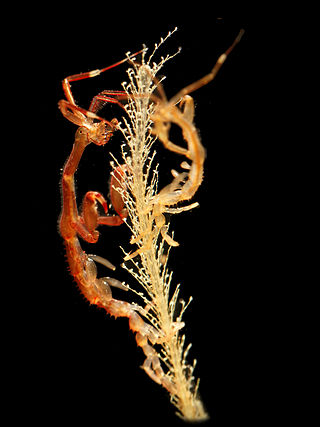
Caprella mutica, commonly known as the Japanese skeleton shrimp, is a species of skeleton shrimp. They are relatively large caprellids, reaching a maximum length of 50 mm (2.0 in). They are sexually dimorphic, with the males usually being much larger than the females. They are characterized by their "hairy" first and second thoracic segments and the rows of spines on their bodies. Body color ranges from green to red to blue, depending on the environment. They are omnivorous highly adaptable opportunistic feeders. In turn, they provide a valuable food source for fish, crabs, and other larger predators. They are usually found in dense colonies attached to submerged man-made structures, floating seaweed, and other organisms.

Harpalus latus is a ground beetle in the subfamily Harpalinae that can be found in Europe, Armenia, Georgia, Kazakhstan, Mongolia, and North Korea. Found in Ontario Canada
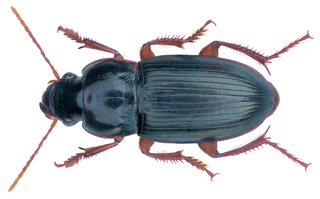
Harpalus smaragdinus is a species of ground beetle native to the Palearctic.
Harpalus chalcentus is a species of ground beetle native to Asia. It is found in Japan and northeastern China. It is also found in North and South Korea.
Harpalus caspius is a species of black coloured ground beetle that can be found in the Near East and the Palearctic realm. In Europe, it can be found in such countries as Austria, Bulgaria, Czech Republic, Germany, Hungary, Moldova, Poland, Romania, Slovakia, Ukraine, all states of former Yugoslavia, and southern part of Russia. It is also found in such Asian countries as Armenia, Azerbaijan, Georgia and Turkey. It is 13 millimetres (0.51 in) in length.
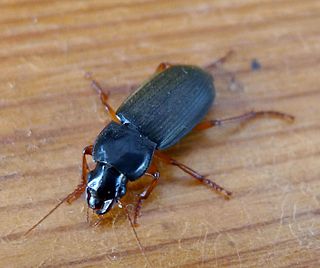
Harpalus rufipes is a species of ground beetle in the subfamily Harpalinae. It was described by Degeer in 1774. Harpalus rufipes is native to Europe. As a predator, Harpalus rufipes is used as a biological agent to control seed-eating pests including aphids and slugs such as Deroceras reticulatum. It has been used as a model organism to investigate the immune system of beetles, and a study has shown it is sensitive to engine oil and diesel oil.
Acroperus tupinamba is a species of crustaceans. Its name refers to the largest tribe of indigenous peoples inhabiting Brazil before European colonization. It was first found among decomposing leaves in Planaltina, Distrito Federal, Brazil. It is a small Acroperus, the length of the female at or below 0.6mm. Its body is egg-shaped, with its maximum height in its body's second quarter. Its dorsal margin is quite arched, with its posteroventral angle denticles being very small. It carries about 35 to 40 ventral setae, with its posterior setae being longer than in cogenerate species. Its head has a low keel, the distance between its eye and the margin of its keel being equal to its eye diameter, which measures 1.5–2 times more than the ocellus. The species' head, antennule and labrum is the same as for the genus. The postabdomen narrows distally, the length of which is about 3.2 its height. Setules near the base of its postabdominal claws are short. Its antenna comprises less than 1/5 of its body length. All of its apical setae are of the same thickness and length. A. tupinamba differs from the other known species of its genus: A. harpae and A. Angustatus, by its smaller size; long posterior setae of the valves; a shorter, wider postabdomen; short setules near the base of its postabdominal claw; and the characteristic morphology of its fourth exopodite's setae 5–6, which is similar to those of Nicsmirnovius.

Gerontoformica is an extinct genus of stem-group ants. The genus contains thirteen described species known from Late Cretaceous fossils found in Asia and Europe. The species were described between 2004 and 2016, with a number of the species formerly being placed into the junior synonym genus Sphecomyrmodes.
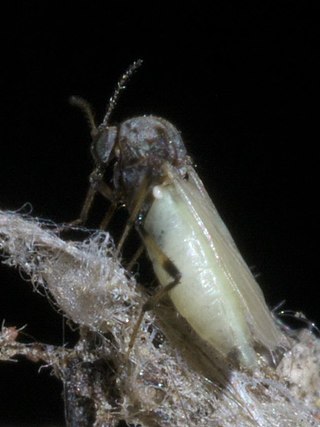
Bezzia nobilis is a species of biting midges in the family Ceratopogonidae. It is widely considered one of the most common Bezzia species; it is found in Eurasian regions, all over the United States, Central America, and even into South American countries like Brazil. B. nobilis seem to prefer aquatic environments; they are commonly observed in stagnant water pools in Eurasia regions and marshes in the southern United States. Adults of this species are easily distinguished by their black and yellow striped legs. Pupae are recognized by their brown bodies, abdominal spines, and respiratory horns. B. nobilis larvae are distinguished by brown heads and white bodies. Little information is known on their life cycle or mating habits. B. nobilis is a predatory species. While some research suggests they mainly feed on larvae of other insect species, experiments suggest they prefer immobile, easy prey such as dead adult flies, bacteria, and protozoa.
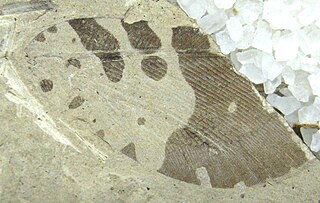
Palaeopsychops is an extinct genus of lacewing in the moth lacewings family Ithonidae. The genus is known from Early Eocene fossils found in Europe, and North America and is composed of ten species. The ten species can be informally separated into two species groups based on veination of the forewings, the "European" and "North American" groups. When first described, the genus was placed in the family Psychopsidae, but later was moved to Polystoechotidae, which itself is now considered a subgroup of the moth lacewings.

Larinus sturnus is a species of cylindrical weevils belonging to the family Curculionidae, subfamily Lixinae.















